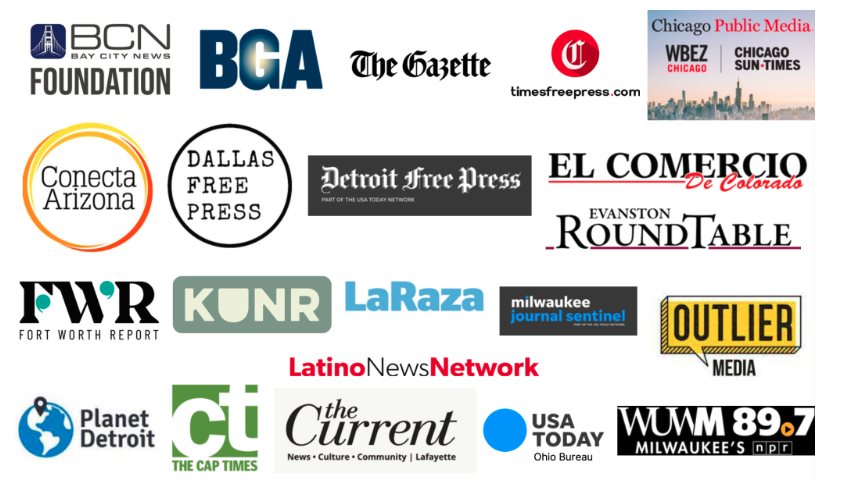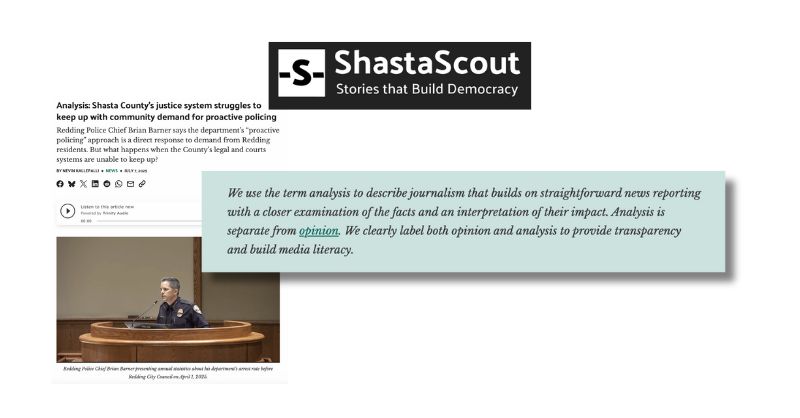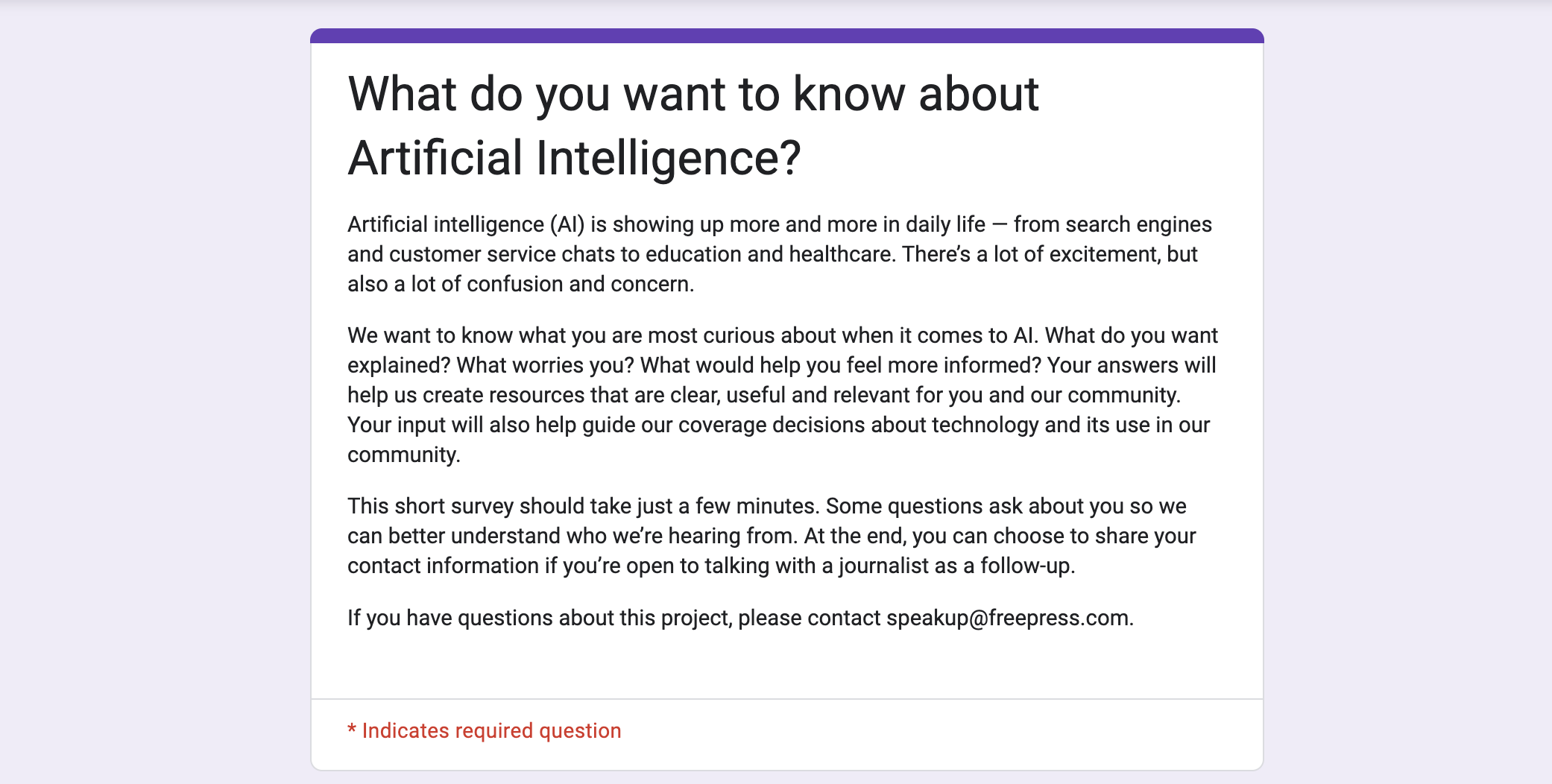
Some of these Advancing Democracy newsrooms used the checklist while covering the election and politics in late 2023. The journalists were asked to take notes on which stories they used the checklist for and answer questions about any changes they made related to sourcing, language (in the story and headline) and story framing.
How newsrooms can use a checklist to avoid polarization in political coverage
Polarizing narratives in news coverage can lead to distrust and news avoidance. This is especially true with topics like politics, where overgeneralizations and the use of sensationalized language in headlines and stories prevent people from engaging with news content — or only engaging with content that fits the narratives they agree with.
At Trusting News, we have been concerned about journalists’ role in producing oversimplified and polarizing news content.
- In 2021, we worked with journalists to understand complaints of polarization in their coverage and potential solutions.
- This led to the creation of an Anti-Polarization Checklist which was developed to help journalists consider what may be missing from their political coverage (the checklist could be used more broadly but was designed with political and election coverage in mind) while also minimizing potentially polarizing language or narratives.
- Journalists have used this checklist and said it improved their news coverage.
While our work in this area shows that journalists can strengthen their coverage by thinking about how to eliminate polarizing narratives and then make changes to content accordingly, there is still too much information being published that oversimplifies complex ideas and pushes people into overgeneralized groups. This prevents communities from being able to understand and have civil conversations around topics like education, healthcare, the environment, immigration, gun rights, etc. Without civil conversations, we are unlikely to find solutions and instead are left with people not having a basic understanding of the issues at hand and arguing and pointing blame while the problems continue to worsen.
Now, not all of this is journalists’ fault. Politicians, government leaders, everyday citizens and bad actors contribute to this problem by spreading misinformation and disinformation and amplifying oversimplified and extreme opinions. But, we believe journalists can and should do more to make sure they are not contributing to this problem.
So, here is our challenge to you: join us! Use our Anti-Polarization Checklist in your political, election and government coverage.
To inspire you and reinforce how this can make a difference in your news coverage and benefit your community, we’re sharing below some highlights of how journalists we worked with in the Advancing Democracy training program used the checklist and what they said about using it. (Advancing Democracy is a partnership with Trusting News, The Solutions Journalism Network, Hearken and Good Conflict. It supports reporters and editors in significantly strengthening journalism’s role in advancing our democracy through innovative approaches that build civic engagement, equity and healthy discourse.)
What journalists learned using our Anti-Polarization Checklist
Advancing Democracy newsrooms used the checklist while covering the election and politics in late 2023. The journalists were asked to take notes on which stories they used the checklist for and answer questions about any changes they made related to sourcing, language (in the story and headline) and story framing.
They told us the checklist helped them:
- Take a closer look at word choice, especially in headlines
- Deepen the number or types of sources included in the story
- Add more context to stories
- Focus on commonalities instead of differences
Headlines and word choice
Sometimes the language changes were as simple as adding qualifiers like the word “most” instead of attaching descriptions to whole groups of people or beliefs. Other times the changes made in language were more nuanced.
In a story about community members attending an event to show support for Israel after the October attack, one journalist said the checklist helped them “avoid divisive tribal language in the headline,” and instead opt for unity as the framing for the headline. In addition, the journalist used “identifiers beyond religion and race to identify congregants and their affiliation with their views.”
Language and decisions about where words were included became an important focus for a story about a possible new middle school in Iowa. The reporter said it took “a lot of time (three hours)” to “balance fact while validating people’s opinions.”
One thing the reporter did in this story was use the subhead to highlight how the opposition group felt about the proposed new school. Using subheads to highlight the pros and cons of an issue or another side or viewpoint can be a good way to show fairness in coverage of a topic. This allows people to see this information right away, instead of leaving readers guessing if it is included or hoping they read it further down the page of the story.
The reporter also worked hard to share the views and opinions of the opposition group even when what they said wasn’t true. Words like “advocated” and “argued” were used to share what they said, and context from educators was added to make sure it was clear what was factual and what was not.
Other examples of language changes and considerations made include:
- Using terms like “undocumented” instead of “illegal” for a story about DACA. Also, consideration was given to the impact of the DACA label.
- Writing headlines in a neutral, not flashy way
- Avoiding pulling a snippet of a quote or the most dramatic quote for use in a headline or a lede
- Avoiding stronger words that suggest a fight like “yell” or “blast,” instead finding more descriptive and straightforward terms to summarize disagreement
- Making sure references to “genocide” and “ethnic cleansing” were in direct quotes
- Not using quotations around the term “fake electors”
- Sticking with AP style when covering abortion, including avoiding the term “pro-life”
- Avoiding using the word “controversial”
Using the checklist helped one reporter think more critically and carefully about the quotes used in the story.
“Thinking about word choice made me more conscious of quote choice and whether the most cynical quotes were essential or whether I’d already made the point about the problems of polarization/civic engagement without belaboring it,” the reporter said.
Another newsroom said the checklist helped them make sure the language they used in a story was consistent with overall newsroom coverage of a topic. To help with this they shared the story with an editor who was overseeing the broader newsroom coverage.
This is good to see because inconsistencies in how you cover a topic and even word choice are often noticed by the public and can lead to distrust. (To learn more about how to get on the record about how you make decisions, why it’s important and how it can build trust, check out this Trust Kit on explaining coverage decisions.)
Deepening sourcing
In reporting on stories related to the conflict between Hamas and Israel, one newsroom included information about why they quoted the sources they did, including the sources’ credibility and expertise. Some of the explanations included: serving in the Israeli military, working in a Palestinian town surrounded by Israeli settlements, having a family member abducted by Hamas and having family that survived the Holocaust.
People sometimes assume we choose sources to push a specific angle, to support our own (or the sources’) agenda, to make one side of a story look bad or good, etc. They might also assume that people are quoted in our stories just because they were nearby and available (which is sometimes true, right?). If this isn’t why you chose a source (most of the time it isn’t!), then including explanations about why you chose a source or why they are qualified to weigh in on a topic or issue can help build trust. (To learn more about how to explain sourcing check out this Trust Kit).
Other examples of how these newsrooms deepened their sourcing include:
- Seeking out Palestinian voices, voices of protesters and a broad range of views while covering stories about Israel, Hamas and Gaza.
- Seeking “a variety of churches and a plurality of recipients to ensure there isn’t one perspective passed off as representing the whole of DACA recipients.”
- Approaching lawmakers who were both Republicans and Democrats to weigh in on why people aren’t running for office. The reporter said they did this because “people affiliated with either major political party may have different opinions on elections.”
- Reaching out to and including the voice of a lawmaker who represents a majority Muslim community for a story about the Israel and Hamas conflict.
- Seeking out and including perspectives and voices not included in coverage before.
- Highlighting the voice of someone who expressed two types of feelings. The reporter used it as a way to signal the depth of feeling — and conflicted feelings.
Providing more context
In a story about the Michigan House not moving a resolution forward, the reporter decided to explain why the legislation did not move forward instead of just saying it didn’t get approved. The reporter said their timing with the story was different than other news outlets.
“It took us additional time to contact the sources we talked to in the piece,” the reporter said. “I think by taking a broader look at why the House hasn’t moved a resolution, we were able to stand out by providing context behind why some lawmakers didn’t want to move such a resolution, instead of just feeding into partisan bickering.”
Other examples of adding context include:
- Providing information about a lawmaker’s voting record lets readers reach conclusions themselves instead of relying on adjectives to describe the lawmakers’ opinions and how they stand on topics.
- Including both the number of Israelis and Palestinians killed and noting that Hamas has been designated as a terrorist organization in stories about the conflict.
- Focusing on the local connection to a story, including reaching out to local leaders for comment, instead of just including the voices of the leading lawmakers who were not from the community.
- Providing context and not allowing lawmakers’ claims to set the tone about what they did. While lawmakers said they were taking a massive step toward transparency, the news organization showed that the measures were closer to the bare minimum.
One reporter mentioned adding context by including definitions and explanations of certain words or phrases. Specifically, the reporter explained what different legal terminology meant and the differences between “clean” and “renewable” energy. Adding definitions to terms and phrases can help people better understand your news stories and find them useful. If people find your content useful they will be more likely to engage with it, instead of avoid it or stop consuming it.
Focusing on commonalities instead of differences
For a story about two council members, who have different views and are on opposite sides of the aisle, a reporter decided to focus the headline and framing of the story on what the council members have in common, instead of focusing on their partisan differences. The headline highlights their military service and the common belief that more should be done for veterans than “a free appetizer on Veterans Day.”
The reporter said, “I really liked this story! I felt like it was a good opportunity to celebrate collaboration.”
In a story about a lack of candidates to fill city council seats the reporter wanted to avoid “leaving readers with a ‘doom and gloom’ ” feeling even though some of the story focused on a lack of civic engagement. To do this the reporter included information about leadership development efforts and a strategy to communicate to residents how they benefit from city services. The reporter said framing the story this way “felt productive for readers while still shedding light on the problem in an honest way.”
Other examples of focusing on collaboration instead of differences include:
- Inviting readers to learn more about this issue without solely focusing on the shock value or entertainment value of the disagreement on a topic.
- Quoting people saying “we can do better” instead of the people yelling for punishment or criticism.
- Making a story about a call to action instead of complaints.
Lingering questions about polarization
While the checklist was helpful for reporters and editors, the journalists who used it still had questions about how to cover particular topics and issues while still avoiding contributing to polarizing narratives.
Specifically, the journalists were left wondering:
- Can you avoid a focus on partisan politics when highlighting a specific race between two politicians?
- Can you avoid highlighting an individual’s impact and their polarizing views or comments in a polarized race?
- How can we follow the speaker race with a precision that doesn’t overblow an individual candidate’s impact?
- How can we give people the information they need without getting lost in the weeds of the conflict?
How does the public respond?
The journalists weren’t instructed to ask for feedback on these stories so there isn’t a lot of information specific to how the public responded to the changes they made. A few did receive some feedback though, including:
- After reporting on a story about the Israel and Hamas conflict, a reporter received an email from sources quoted in the story thanking the paper for “beautiful and incredibly prompt” and “thoughtful” coverage. For that same story, the reporter also received an email from a reader thanking the paper for providing “intelligent, direct remarks from the younger generation.”
- For a political story, a reporter received feedback feedback from one of the lawmakers and some readers that the story was written fairly.
- For a story about proposed rules about eviction, a reporter said, “there was lots of discourse in the comments section, but I actually thought it was more productive than our some of our previous housing stories.”
At Trusting News we plan to continue to use this checklist, improve it and possibly expand it to other subject matters. One important part of this will be to incorporate more direct requests for feedback into the use of the checklist so we can see how the public responds to changes. We want to know if they notice differences in the stories and language and most importantly, if it increases trust and results in more helpful, useful and nuanced coverage of their communities.
If you have ideas on how to improve the checklist or use it in your coverage we would love to hear from you. Contact us at info@trustingnews.org.
Trusting News would like to thank the following newsrooms and journalists who used the Anti-Polarization Checklist in their news coverage, helping us learn more about how journalists can work to avoid polarization in their reporting:
- Fort Worth Report: Rachel Behrndt
- The Gazette: Grace King, Marissa Payne
- Detroit Free Press: Arpan Lobo
- Evanston RoundTable: Duncan Agnew
- WBEZ
At Trusting News, we learn how people decide what news to trust and turn that knowledge into actionable strategies for journalists. We train and empower journalists to take responsibility for demonstrating credibility and actively earning trust through transparency and engagement. Subscribe to our Trust Tips newsletter. Follow us on Twitter and Facebook. Read more about our work at TrustingNews.org.

Assistant director Lynn Walsh (she/her) is an Emmy award-winning journalist who has worked in investigative journalism at the national level and locally in California, Ohio, Texas and Florida. She is the former Ethics Chair for the Society of Professional Journalists and a past national president for the organization. Based in San Diego, Lynn is also an adjunct professor and freelance journalist. She can be reached at lynn@TrustingNews.org and on Twitter @lwalsh.



